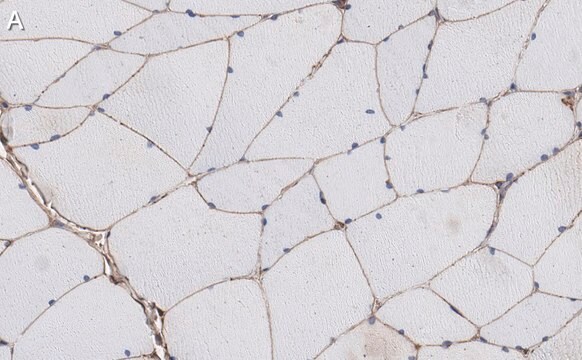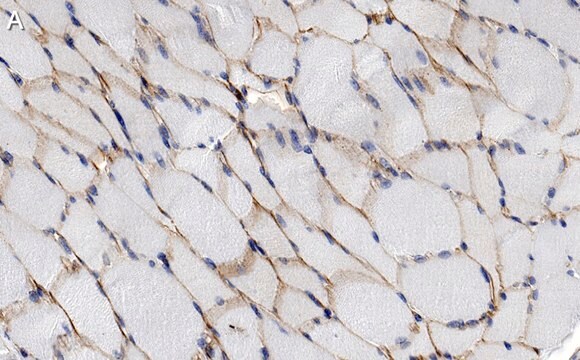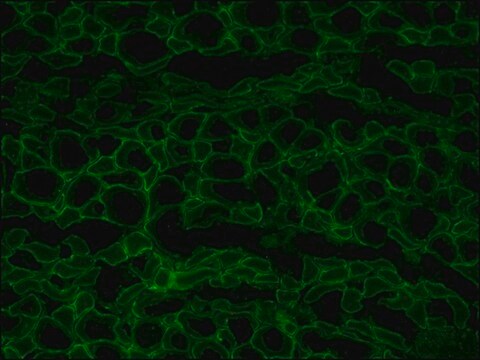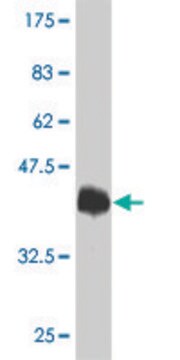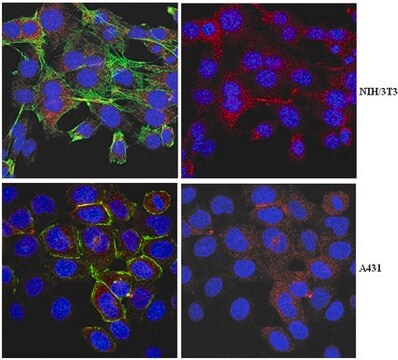05-593-I
Anti-α-Dystroglycan Antibody
Sinónimos:
Dystroglycan antibody
About This Item
Productos recomendados
origen biológico
mouse
Nivel de calidad
conjugado
unconjugated
forma del anticuerpo
purified antibody
tipo de anticuerpo
primary antibodies
clon
IIH6 (or IIH6C4), monoclonal
mol peso
calculated mol wt 97.03 kDa
observed mol wt ~43 and 156 kDa
reactividad de especies
rabbit, human, mouse
reactividad de especies (predicha por homología)
guinea pig, canine, rat
envase
antibody small pack of 100 μL
isotipo
IgM
Nº de acceso UniProt
Condiciones de envío
dry ice
temp. de almacenamiento
-10 to -25°C
modificación del objetivo postraduccional
unmodified
Información sobre el gen
rabbit ... DAG1(100009278)
Descripción general
Especificidad
Inmunógeno
Aplicación
Evaluated by Western Blotting in Rabbit skeletal muscle tissue lysate.
Western Blotting Analysis: 1:1,000 of this antibody detected Dystroglycan in Rabbit skeletal muscle tissue lysate.
Tested Applications
Western Blotting Analysis: A representative lot detected Dystroglycan in Western Blotting applications (Azzag, K., et. al. (2020). Skelet Muscle. 10(1):10 ; Bijata, M., et. al. (2015). Front Cell Neurosci. 9:199).
Immunohistochemistry (Paraffin) Analysis: A 1:50 dilution from a representative lot detected Dystroglycan in mouse heart and mouse skeletal muscle tissue sections.
Flow Cytometry Analysis: A representative lot detected Dystroglycan in Flow Cytometry applications (Gerin, I., et. al. (2016). Nat Commun. 7:11534).
Immunofluorescence Analysis: A representative lot detected Dystroglycan in Immunofluorescence applications (Azzag, K., et. al. (2020). Skelet Muscle. 10(1):10).
Inhibition Analysis: A representative lot reduced agrin-induced ERK activation in cardiac cells. (Bassat, E., et. al. (2017). Nature. 547(7662):179-184)
Immunohistochemistry Applications: A representative lot detected -Dystroglycan in Immunohistochemistry applications (Cataldi, M.P., et. al. (2018). Nat Commun. 9(1):3448).
Immunocytochemistry Analysis: A representative lot detected Dystroglycan in Immunocytochemistry applications (Bijata, M., et. al. (2015). Front Cell Neurosci. 9:199).
Note: Actual optimal working dilutions must be determined by end user as specimens, and experimental conditions may vary with the end user
Forma física
Almacenamiento y estabilidad
Otras notas
Cláusula de descargo de responsabilidad
¿No encuentra el producto adecuado?
Pruebe nuestro Herramienta de selección de productos.
Opcional
Código de clase de almacenamiento
10 - Combustible liquids
Clase de riesgo para el agua (WGK)
WGK 1
Punto de inflamabilidad (°F)
Not applicable
Punto de inflamabilidad (°C)
Not applicable
Certificados de análisis (COA)
Busque Certificados de análisis (COA) introduciendo el número de lote del producto. Los números de lote se encuentran en la etiqueta del producto después de las palabras «Lot» o «Batch»
¿Ya tiene este producto?
Encuentre la documentación para los productos que ha comprado recientemente en la Biblioteca de documentos.
Nuestro equipo de científicos tiene experiencia en todas las áreas de investigación: Ciencias de la vida, Ciencia de los materiales, Síntesis química, Cromatografía, Analítica y muchas otras.
Póngase en contacto con el Servicio técnico